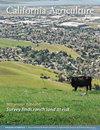Winter flooding recharges groundwater in almond orchards with limited effects on root dynamics and yield
IF 1.1
4区 农林科学
Q2 AGRICULTURE, MULTIDISCIPLINARY
引用次数: 3
Abstract
California signed the Sustainable Groundwater Management Act (SGMA) into law in 2014. SGMA requires groundwater-dependent regions to halt overdraft and develop plans to reach an annual balance of pumping and recharge. Groundwater aquifers can be recharged by flooding agricultural fields when fallow, but this has not been an option for perennial crops such as fruit and nut trees. While flooding these crops might be possible during the dormant season, it is not known what impact flooding might have on tree-root systems, health and yield. We followed root production, tree water status and yield in two almond orchards in Northern California for 2 years to test the impact of applying captured winter water runoff for groundwater recharge purposes on tree performance. Results showed that more than 90% of the water applied to sandy soil and 80% of the water applied to loamy soil percolated past the root zones, with no measured adverse effects on tree water status, canopy development or yield. Groundwater recharge did not negatively affect new root production and tended to extend root lifespan. Based upon these data, applying additional water in late December and January is not likely to have negative impacts on almond orchards in moderately drained to well-drained soils.冬季洪水对杏仁果园根系动态和产量的影响有限
2014年,加州签署了《可持续地下水管理法》(SGMA),使之成为法律。SGMA要求依赖地下水的地区停止透支,并制定计划以达到抽水和补给的年度平衡。地下水含水层可以在休耕时通过淹没农田来补充,但这并不是水果和坚果树等多年生作物的选择。虽然在休眠季节可能会淹没这些作物,但尚不清楚洪水对树根系统、健康和产量会产生什么影响。我们对北加州的两个杏树果园的根系生产、树木水分状况和产量进行了为期两年的跟踪研究,以测试应用捕获的冬季径流用于地下水补给对树木性能的影响。结果表明,沙质土壤90%以上的水分和壤土80%以上的水分通过根区渗透,对树木水分状况、冠层发育和产量均无不利影响。地下水补给对新根的产生没有负面影响,并有延长根系寿命的趋势。根据这些数据,在12月下旬和1月加水不太可能对中等排水至良好排水土壤的杏仁园产生负面影响。
本文章由计算机程序翻译,如有差异,请以英文原文为准。
求助全文
约1分钟内获得全文
求助全文
来源期刊

California Agriculture
农林科学-农业综合
CiteScore
2.40
自引率
7.70%
发文量
17
审稿时长
>12 weeks
期刊介绍:
Information not localized
 求助内容:
求助内容: 应助结果提醒方式:
应助结果提醒方式:


